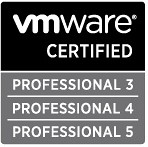To understand vCOPS and its metrics one needs to understand the below mentioned metrics. I thought to add this on my blog site to help me. Hope this helps you too.
Provisioned
Amount of a resource that the user configures.The provisioned metric might apply to the amount of physical memory for a host or the number of vCPUs for a virtual machine.
Usable
Actual amount of a resource that the object can use. The usable amount is less than or equal to the provisioned amount. The difference between the provisioned amount and usable amount stems from factors such as hardware capacity and virtualization overhead. This overhead might include the memory that an ESX host uses to run the host, to support reservations for virtual machines, and to add a buffer for high availability. The usable metric does not apply to virtual machines.
Usage
Amount of a resource that an object consumes. The usage amount is less than or equal to the usable amount.
Demand
Amount of a physical resource that the object might consume without any existing constraints. An object becomes constrained because of under provisioning or contention with other consumers of the
resource.
A virtual machine might need 10GB of memory but can only get 5GB because the virtual machine must share resources with other virtual machines on the host.When the demand amount is less than the usage amount, the environment might have wasted resources. When the demand amount is greater than the usage amount, the environment might incur latency and exhibit decreased performance.
Contention
Effect of the difference between the amount of the resource that the object requires and the amount of the resource that the object gets.
This metric measures the effect of conflict for a resource between consumers. Contention measures latency or the amount of time it takes to gain access to a resource. This measurement accounts for dropped packets for networking.
Limit
Maximum amount that an object can get from a resource. The limit sets the upper bound for CPU, memory, or disk I/O resources that you allocate and configure in vCenter Server.
The usage amount is less than or equal to the limit amount. The demand amount can be greater than the limit amount. The limit amount is less than or equal to the provisioned amount.
The default limit amount is unlimited.
Rules: Usage <= Limit
Demand can be greater than Limit .
Reservation
Guaranteed amount of resources for an object. The object does not start without this reserved amount. The default amount is 0.
Entitlement
Amount of a resource that a virtual machine can use based on the relative priority of that consumer set by the virtualization configuration. This metric is a function of provisioned resources, limit, reservation, shares, and demand. Shares involve proportional weighting that indicates the importance of a virtual machine.
The entitlement amount is less than or equal to the limit amount. The only case in which entitlement is less than provisioned is when the total provisioned amount is greater than total capacity.
The entitlement metric applies only to virtual machines.
Rules: Entitlement <= Limit <= Provisioned
Entitlement >= Reservations
Source vCenter Operations Advance Getting started Guide.


Leave a Reply